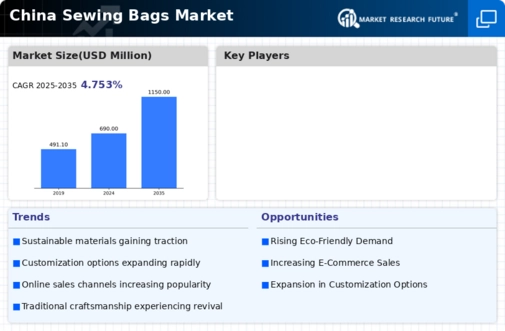Growth of DIY Culture
The sewing bags market in China is benefiting from the burgeoning DIY culture, which has gained traction among various demographics. This trend is particularly popular among younger consumers who seek to express their creativity through personalized sewing projects. The rise of social media platforms has facilitated the sharing of DIY tutorials and ideas, further fueling interest in sewing. As a result, the market for sewing bags is projected to grow by approximately 15% annually as more individuals engage in sewing as a hobby. This cultural shift not only increases demand for sewing bags but also encourages local artisans and small businesses to enter the sewing bags market, thereby diversifying the product offerings available to consumers.
Increased Online Retailing
The sewing bags market in China is witnessing a significant transformation due to the rise of online retailing. E-commerce platforms have made it easier for consumers to access a wide variety of sewing bags, often at competitive prices. In 2025, online sales are expected to represent over 40% of total market sales, driven by the convenience of shopping from home and the availability of diverse product options. This shift is prompting traditional retailers to enhance their online presence, thereby increasing competition within the sewing bags market. As a result, consumers benefit from better pricing and a broader selection of products, which may further stimulate market growth.
Influence of Fashion Trends
The sewing bags market in China is significantly influenced by evolving fashion trends. As fashion cycles change, so do consumer preferences for styles, colors, and materials in sewing bags. In recent years, there has been a noticeable shift towards minimalist designs and multifunctional bags that cater to both aesthetic and practical needs. This trend is expected to drive a 20% increase in demand for sewing bags that align with current fashion sensibilities. The sewing bags market must remain agile to adapt to these trends, ensuring that manufacturers can meet the dynamic demands of fashion-conscious consumers.
Rising Demand for Eco-Friendly Products
The sewing bags market in China is experiencing a notable shift towards eco-friendly products. As consumers become increasingly aware of environmental issues, there is a growing preference for sustainable materials. This trend is reflected in the rising sales of bags made from organic cotton, recycled polyester, and other biodegradable materials. In 2025, it is estimated that the market for eco-friendly sewing bags could account for approximately 30% of total sales. This shift not only aligns with consumer values but also encourages manufacturers to innovate in sustainable practices, thereby enhancing their market position. The sewing bags market is thus likely to see a significant transformation as brands adapt to these changing consumer preferences.
Government Support for Local Manufacturing
The sewing bags market in China is poised for growth due to increased government support for local manufacturing initiatives. Policies aimed at promoting domestic production and reducing reliance on imports are encouraging local businesses to invest in the sewing bags market. This support includes financial incentives, training programs, and infrastructure development, which collectively enhance the competitiveness of local manufacturers. As a result, the market is expected to grow by approximately 10% over the next few years, as local brands gain market share and consumers increasingly favor domestically produced goods. The sewing bags market is thus likely to benefit from this favorable regulatory environment.











Leave a Comment